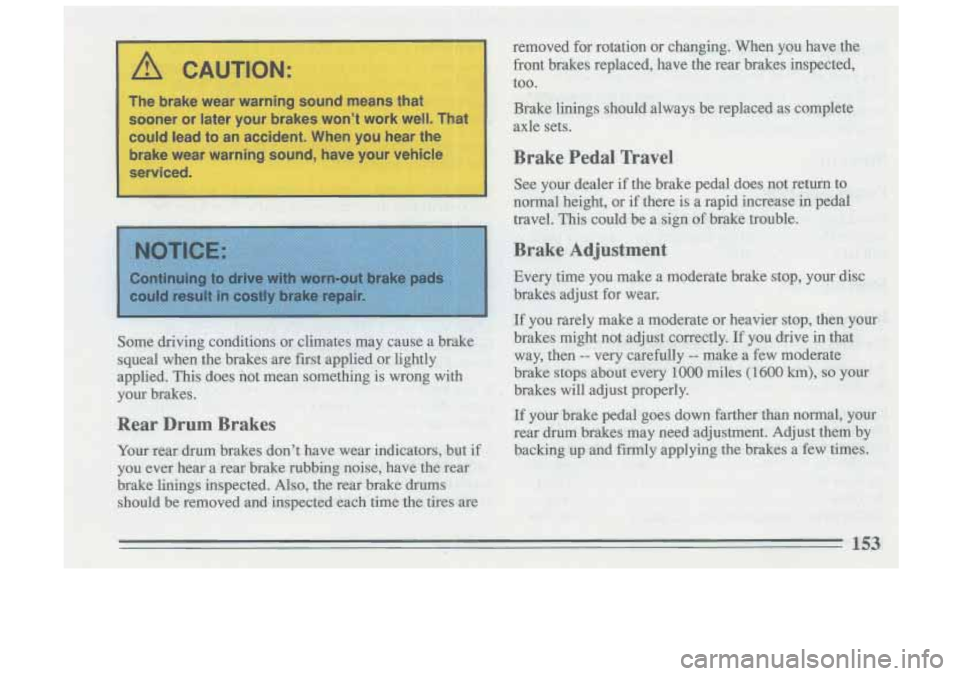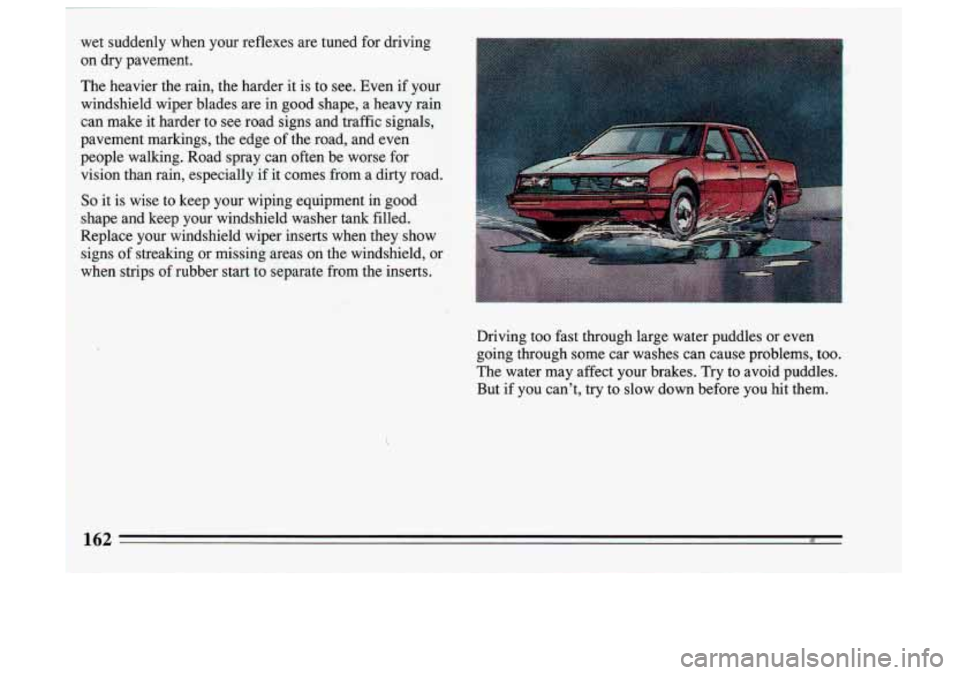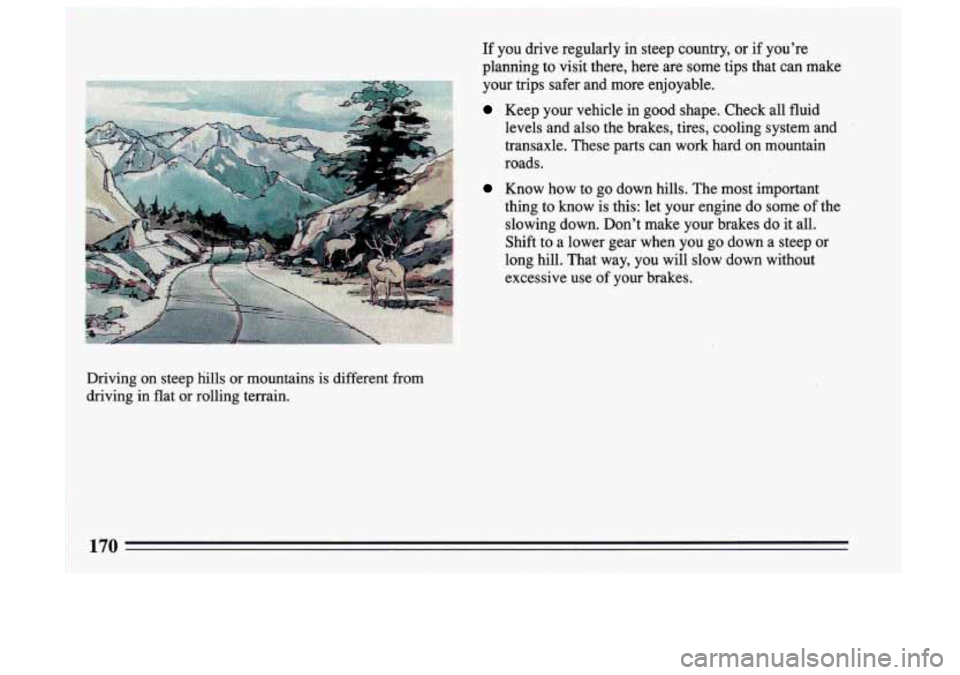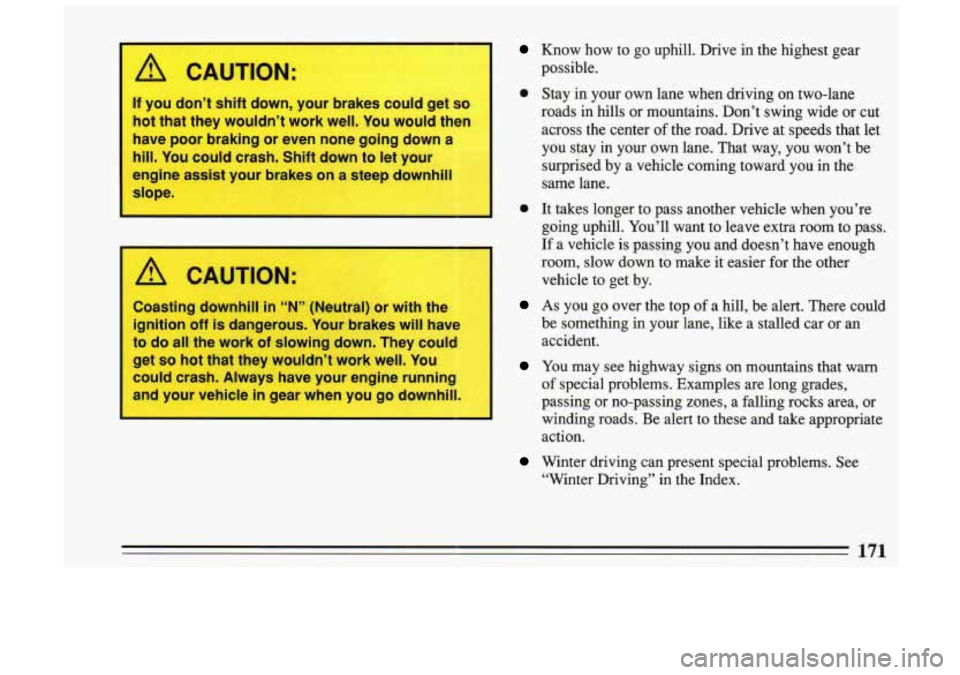1993 BUICK SKYLARK brakes
[x] Cancel search: brakesPage 153 of 306

A computer senses that wheels are slowing down. The
computer separately works the brakes at each fmnt
wheel and at the rear wheels.
The anti-lock system can change the brake pressure
faster than any driver could. The computer is
programmed to make the most
of available tire and road
conditions.
__
r
You can steer around the obstacle while braking hard.
As you brake, your computer keeps receiving updates on
wheel speed and controls braking pressure accordingly.
A CAUTION:
Anti-lock doesn’t change the time you need to
get your foot up to the brake pedal.
If you get too
close to the vehicle
in front of you, you won’t
have time to apply your brakes
if that vehicle
suddenly slows or stops. Always leave enough
room up ahead to stop, even though you have
anti-lock brakes.
To Use Anti-Lock:
Don’t pump the brakes. Just hold the brake pedal down
and let anti-lock work for you. You also may hear a
clicking noise as you accelerate after a hard stop.
Disc Brake Wear Indicators
Your Buick has front disc brakes and rear drum brakes.
Disc brake pads have built-in wear indicators that make
a high-pitched warning sound when the brake pads are
worn and new pads are needed. The sound may come and
go or be heard all the time your vehicle is moving (except
when you are pushing on the brake pedal firmly).
Page 154 of 306

A CAUTION:
The brake wear warning sound means that could lead to an accident. When you hear the
brake wear warning sound, have your vehicle
sooner or later your
brakes won’t work well. That
Page 156 of 306

When you drive into a curve at night, it's harder to see
the road ahead
of you because it bends away from the
straight beams
of your lights. This is one good reason to
drive slower.
Steering in Emergencies
There are times when steering can be more effective
than braking. For example,
you come over a hill and
find a truck stopped in your lane, or a car suddenly pulls
out from nowhere, or a child darts out from between
parked cars and stops right in front
Qf you. You can
avoid these problems by braking
-- if you can stop in
time. But sometimes you can't; there isn't room. That's
the time for evasive action
-- steering around the
problem.
Your Buick can perform very well in emergencies like
these. First apply your brakes. It is better to remove as
much speed as you can from a possible collision. Then
steer around the problem, to the left or right depending
on the space available.
An emergency like this requires close attention and a
quick decision.
If you are holding the steering wheel at
the recommended
9 and 3 o'clock positions, you can
turn it a full
180 degrees very quickly without removing
either hand. But you have to act fast, steer quickly, and just as
quickly straighten the wheel once you have
avoided the object. You must then be prepared to steer
back to your original lane and then brake to a controlled
stop.
Depending
on your speed, this can be rather violent for
an unprepared driver. This is one of the reasons driving
experts recommend that you use your safety belts and
keep both hands on the steering wheel.
-1
3'
The fact that such emergency situations are always
possible is a good
reason to practice defensive driving at
all times.
155
Page 159 of 306

0
0
0
Try not to pass more than one vehicle at a time on
two-lane roads. Reconsider before passing the next
vehicle.
Don’t overtake a slowly moving vehicle too rapidly.
Even though the brake lights are not flashing, it may
be slowing down or starting to turn.
If you’re being passed, make it easy for the
following driver to get ahead of you. Perhaps you
can ease a.little to the right.
Loss of Control
Let’s review what driving experts say about what
happens when the three control systems (brakes, steering and acceleration) don’t have enough friction where the
tires meet the road to do what the driver has asked.
In any emergency, don’t give up. Keep trying to steer
and constantly seek an escape route or area of less
danger.
Skidding
In a skid, a driver can lose control of the vehicle.
Defensive drivers avoid most skids by taking reasonable
care suited to existing conditions, and by not
“overdriving” those conditions. But skids are always
possible. The three types
of skids correspond
to your Buick’s
three control systems. In the braking skid your wheels
aren’t rolling.
In the steering or cornering skid, too
much speed or steering in a curve causes tires to slip and
lose cornering force. And in the acceleration skid too
much throttle causes the driving wheels to spin.
A cornering skid and an acceleration skid are best
handled by easing your foot off the accelerator pedal.
If your vehicle starts to slide (as when you- turn a corner
on a wet, snow- or ice-covered road), ease your foot
off
the accelerator pedal as soon as you feel the vehicle start
to slide. Quickly steer the way you want the vehicle to
go. If you start steering quickly enough, your vehicle
will straighten out. As it does, straighten the front
wheels.
Of course, traction is reduced when water, snow, ice,
gravel, or other material is on the road. For safety, you’l\
l
..
want to slow down and adjust your driving to these
conditions. It is important to slow down on slippery
surfaces because stopping distance will be longer and
vehicle control more limited.
While driving on a surface with reduced traction, try
your best to avoid sudden steering, acceleration, or
braking (including engine braking by shifting to a lower gear). Any sudden changes could cause the tires to slide.
You may not realize the surface is slippery until your
I
Page 163 of 306

wet suddenly when your reflexes are tuned for driving
on dry pavement.
The heavier the rain, the harder it is to see. Even if your
windshield wiper bladesare in good shape, a heavy rain
can make it harder to see road signs and traffic signals,
pavement markings, the edge of the road, and even
people walking. Road spray can often be worse
for
vision than rain, especially if it comes from a dirty road.
So it is wise to keep your wiping equipment in good
shape and keep your windshield washer tank filled.
Replace your windshield wiper inserts when they
show
signs of streaking or missing areas on the windshield, or
when strips of rubber start to separate from the inserts.
1 L3
Driving too fast through large water puddles or even
going through some car washes can cause problems, too.
The water may affect your brakes. Try to avoid puddles. But
if you can't, try to slow down before you hit them.
Page 164 of 306

A CAUTION:
Wet brakes can cause accidents. The: ton’t
work well in
a quick stop and may cause pulling
to one side. You could lose control of the vehicle.
After driving through a large puddle of water or
car wash, apply your brake pedal ligh rtil
your brakes work normally.
Hydroplaning
Hydroplaning is dangerous. So much water can build up
under your tires that they can actually ride on the water.
This can happen if the road is wet enough and you’re
going fast enough. When your vehicle is hydroplaning,
it has little or no contact with the road.
You might not be aware of hydroplaning. You could drive
along for some time without realizing your tires aren’t in
constant contact with the road. -You could find out the
hard way: when you have to slow, turn, move out to,pass
-- or if you get hit by a gust of wind. You could suddenly
fiid yourself out of control.
Hydroplaning doesn’t happen often. But it can if your
tires haven’t much tread or if the pressure in ?ne or more
is low. It can happen
if a lot of water is standing on the road. If you can
see reflections from trees, telephone
poles, or other vehicles, and raindrops “dimple” the water’s surface, there could
be hydroplaning.
Hydroplaning usually happens at higher speeds. There
just isn’t a hard and fast rule about hydroplaning. The
best advice is to
slow down when it is raining, and be
careful.
Some Other Rainy Weather Tips
0 Turn on your headlights -- not just your parang
lights
-- to help make you more visible to others.
0 Look for hard-to-see vehicles coming from behind.
You may want to use your headlights even in
daytime if it’s raining hard.
0 Besides slowing down, allow some extra following
distance. And be especially careful when you pass
another vehicle. Allow yourself more clear room
ahead, and
be prepared to have your view restricted
by road spray.
If the road spray is so heavy you are
actually blinded, drop back. Don’t pass until
conditions improve. Going more slowly is better
than having an accident.
Use your defogger if it helps.
Have good tires with proper tread depth. (See “Tires” in the Index.)
163
Page 171 of 306

Driving on steep hills or mountains is different from
driving in flat or rolling terrain. If you
drive regularly in steep country, or if you’re
planning to visit there, here are some tips that can make
your trips safer and more enjoyable.
Keep your vehicle in good shape. Check all fluid
levels and also the brakes, tires, cooling system and
transaxle. These parts can work hard on mountain
roads.
Know how to go down hills. The most important
thing to know is this: let your engine do some of the
slowing down. Don’t make your brakes do it all.
Shift to a lower gear when you go down a steep or
long hill. That way, you will slow down without
excessive use of your brakes.
I 170
Page 172 of 306

1 CAUTION:
If you don’t shift down, your brakes COL., get so
hot that they wouldn’t work well. You would then
have poor braking or even none going down a
3‘
hill. You could crash. Shift down to let your
engine assist your brakes on a steep downhi
Know.how to go uphill. Drive in the highest gear
possible.
slope.
I.
A CAUTION:
Coasting downhill in “N” (Neutr; or with the
ignition off is dangerous. Your brakes will have
to do all the work of slowing down. They cou
get
so hot that they wouldn’t work well. You
could crash. Always have your engine running
and your vehicle
in gear when you go downh
Stay in your own lane when driving on two-lane
roads in hills or mountains. Don’t swing wide or cut
across the center
of the road. Drive at speeds that let
you stay in your own lane. That way, you won’t be surprised by a vehicle coming toward you in the
same lane.
It takes longer to pass another vehicle when you’re
going uphill. You’ll want to leave extra room to pass.
If a vehicle is passing you and doesn’t have enough
room, slow down to make it easier €or the other
vehicle to get by.
..
1
I As you go over the top of a hill, be alert. There could
be something in your lane, like a stalled car or an
accident.
of special problems. Examples are long grades,
I
passing or no-passing zones, a falling rocks area, or 1
winding roads. Be alert to these and take appropriate
action.
I You may see highway signs on mountains that warn
Winter driving can present special problems. See
“Winter Driving” in the Index.
171